NCERT Solutions | Class 11 Chemistry Chapter 5 | States of Matter

CBSE Solutions | Chemistry Class 11
Check the below NCERT Solutions for Class 11 Chemistry Chapter 5 States of Matter Pdf free download. NCERT Solutions Class 11 Chemistry were prepared based on the latest exam pattern. We have Provided States of Matter Class 11 Chemistry NCERT Solutions to help students understand the concept very well.
NCERT | Class 11 Chemistry
| Book: | National Council of Educational Research and Training (NCERT) |
|---|---|
| Board: | Central Board of Secondary Education (CBSE) |
| Class: | 11th |
| Subject: | Chemistry |
| Chapter: | 5 |
| Chapters Name: | States of Matter |
| Medium: | English |
States of Matter | Class 11 Chemistry | NCERT Books Solutions
NCERT Exercises
NCERT Solutions for Class 11 Chemistry Chapter 5, Question 1.
Solution.
According to Boyle’s law, at constant temperature,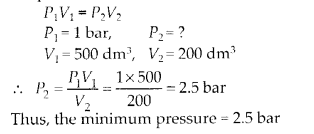
NCERT Solutions for Class 11 Chemistry Chapter 5, Question 2.
Solution.
Since temperature and amount of gas remain constant, therefore, Boyle’s law is applicable.
NCERT Solutions for Class 11 Chemistry Chapter 5, Question 3.
Solution.
According to ideal gas equation for ‘n’ moles of a gas,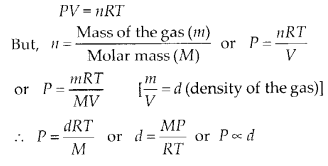
NCERT Solutions for Class 11 Chemistry Chapter 5, Question 4.
Solution.

NCERT Solutions for Class 11 Chemistry Chapter 5, Question 5.
Solution.
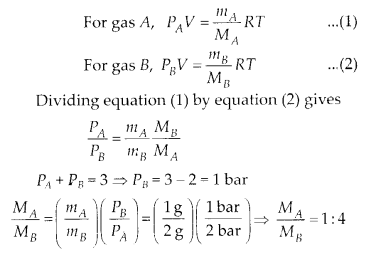
NCERT Solutions for Class 11 Chemistry Chapter 5, Question 6.
Solution.
The reaction between aluminium and caustic soda is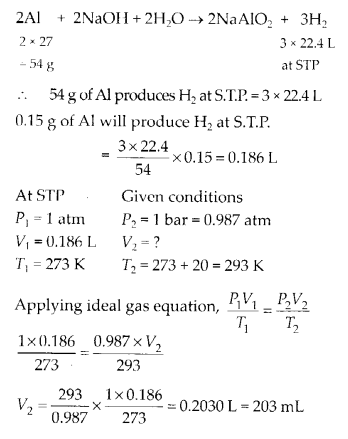
NCERT Solutions for Class 11 Chemistry Chapter 5, Question 7.
Solution.
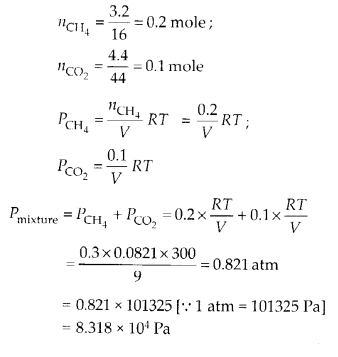
NCERT Solutions for Class 11 Chemistry Chapter 5, Question 8.
Solution.
Partial pressure of hydrogen gas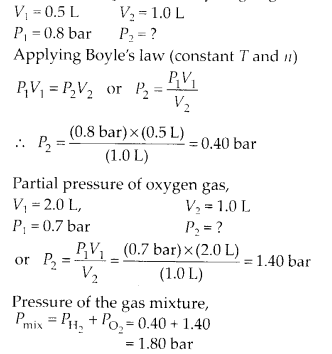
NCERT Solutions for Class 11 Chemistry Chapter 5, Question 9.
Solution.
We know that PV = nRT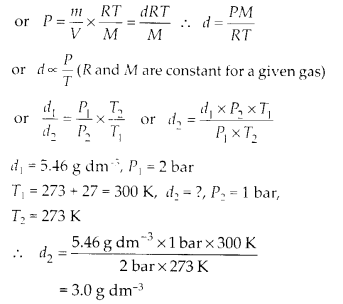
NCERT Solutions for Class 11 Chemistry Chapter 5, Question 10.
Solution.
Molar mass of phosphorus, M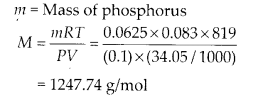
NCERT Solutions for Class 11 Chemistry Chapter 5, Question 11.
Solution.
Suppose the number of moles of gas present at 27°C in flask of volume V at pressure P is n1 then assuming ideal gas behaviour,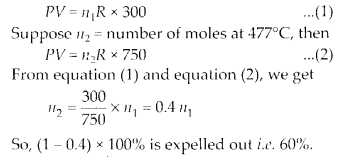
NCERT Solutions for Class 11 Chemistry Chapter 5, Question 12.
(R – 0.083 bar dm3 K-1 mol-1)
Solution.
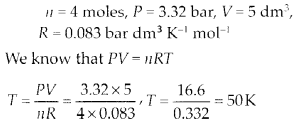
NCERT Solutions for Class 11 Chemistry Chapter 5, Question 13.
Solution.
Number of moles of dinitrogen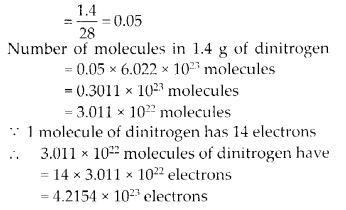
NCERT Solutions for Class 11 Chemistry Chapter 5, Question 14.
Solution.
Time taken to distribute 1010 grains = 1 sec.Time taken to distribute 6.023 x 1023 grains
\(=\frac { 1\times 6.022\times { 10 }^{ 23 } }{ { 10 }^{ 10 } } =6.022\times { 10 }^{ 23 }\quad sec\)
\(=\frac { 6.022\times { 10 }^{ 13 } }{ 60\times 60\times 24\times 365 } =1.90956\times { 10 }^{ 6 }\quad years\)
NCERT Solutions for Class 11 Chemistry Chapter 5, Question 15.
R = 0.083 bar dm3 K-1 mol-1
Solution.
Partial pressure of oxygen gas,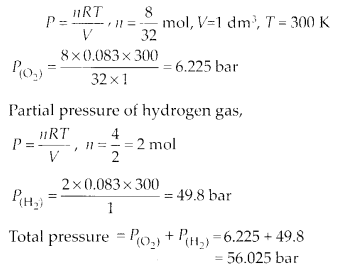
NCERT Solutions for Class 11 Chemistry Chapter 5, Question 16.
Solution.
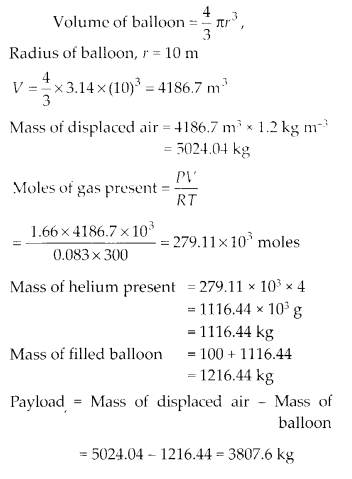
NCERT Solutions for Class 11 Chemistry Chapter 5, Question 17.
(R = 0.083 bar L K-1 mol-1)
Solution.
According to ideal gas equation, PV= nRT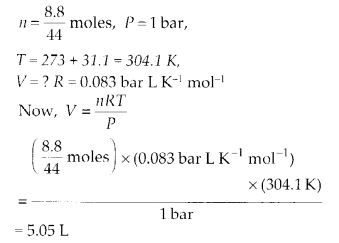
NCERT Solutions for Class 11 Chemistry Chapter 5, Question 18.
Solution.
Let molar mass of gas = M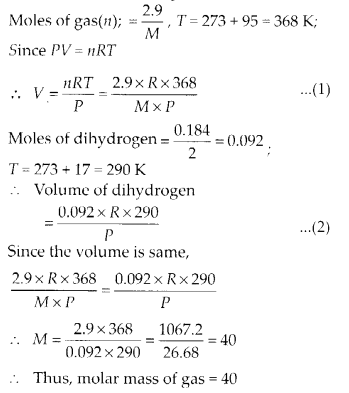
NCERT Solutions for Class 11 Chemistry Chapter 5, Question 19.
Solution.
Let the total mass of the mixture be 100 g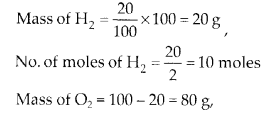
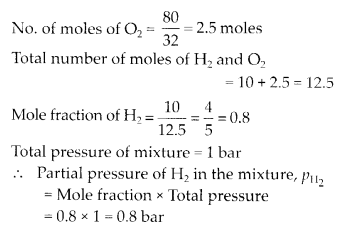
NCERT Solutions for Class 11 Chemistry Chapter 5, Question 20.
Solution.

NCERT Solutions for Class 11 Chemistry Chapter 5, Question 21.
Solution.
According to Charles’ law,Volume of gas at 1°C,
\({ V }_{ t }={ V }_{ 0 }\left[ 1+\frac { t }{ 273 } \right] \) (∵ V0 = Volume at 0°C)
Volume of gas at -273°C, \(V={ V }_{ 0 }\left[ 1+\frac { 273 }{ 273 } \right] =0\)
Thus, -273°C is the lowest possible temperature because below this temperature, the volume will become negative, and that is meaningless. This lowest temperature is called absolute zero temperature.
NCERT Solutions for Class 11 Chemistry Chapter 5, Question 22.
Solution.
Higher the critical temperature, more easily the gas can be liquefied i.e. greater are the intermolecular forces of attraction, CO2 has stronger intermolecular forces than methane.NCERT Solutions for Class 11 Chemistry Chapter 5, Question 23.
Solution.
van der Waals constant ‘a’ is a measure of the magnitude of the attractive forces among the molecules of a gas, while constant ‘b’ is a measure of effective size of the gas molecules.NCERT Class 11 Chemistry
Class 11 Chemistry Chapters | Chemistry Class 11 Chapter 5
Chapterwise NCERT Solutions for Class 11 Chemistry
-
NCERT Solutions For Class 11 Chemistry Chapter 1 Some Basic Concepts of Chemistry
NCERT Solutions For Class 11 Chemistry Chapter 2 Structure of The Atom
NCERT Solutions For Class 11 Chemistry Chapter 3 Classification of Elements and Periodicity in Properties
NCERT Solutions For Class 11 Chemistry Chapter 4 Chemical Bonding and Molecular Structure
NCERT Solutions For Class 11 Chemistry Chapter 5 States of Matter
NCERT Solutions For Class 11 Chemistry Chapter 6 Thermodynamics
NCERT Solutions For Class 11 Chemistry Chapter 7 Equilibrium
NCERT Solutions For Class 11 Chemistry Chapter 8 Redox Reactions
NCERT Solutions For Class 11 Chemistry Chapter 9 Hydrogen
NCERT Solutions For Class 11 Chemistry Chapter 10 The sBlock Elements
NCERT Solutions For Class 11 Chemistry Chapter 11 The pBlock Elements
NCERT Solutions For Class 11 Chemistry Chapter 12 Organic Chemistry: Some Basic Principles and Techniques
NCERT Solutions For Class 11 Chemistry Chapter 13 Hydrocarbons
NCERT Solutions For Class 11 Chemistry Chapter 14 Environmental Chemistry
| NCERT Solutions for Class 12 All Subjects | NCERT Solutions for Class 10 All Subjects |
| NCERT Solutions for Class 11 All Subjects | NCERT Solutions for Class 9 All Subjects |

Post a Comment
इस पेज / वेबसाइट की त्रुटियों / गलतियों को यहाँ दर्ज कीजिये
(Errors/mistakes on this page/website enter here)